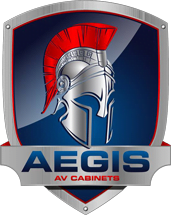

Thankfully there is a REAL ANSWER – Aegis AV Cabinets
By: Michael Kelley
Most home designs built today have little respect for the demands of home audio/video equipment. Yet with technology advancing quickly, Smart Home getting more popular and technology playing a bigger role than ever in our lives, the importance of providing AV electronics with safe, convenient, and attractive housing for their AV equipment.
During my time in the Marine Corps, I was an electronics technician on air station navigational aids, radars, and communications equipment. Most of the time I worked on radios by repairing circuit boards, replacing parts, and fine tuning . They were advanced for their time, but had been in opertion for years. Even though they were old they still worked well. They did so for two main reasons; they were kept in a cool environment and they were kept dust free.
I have always been an AV and home theater enthusiast. Over the years the technology has advanced to what would have been considered sorcery back in the day, but the common need to ensure its longevity has never changed.
Over the years I have seen equipment trends go from being displayed in AV furniture to being installed in non ventilated cabinets, pantry’s and linen closets: where they would eventually malfunction or burn out. Hiding the AV gear away seems to have become standard policy. I recently toured a beautiful high-end home and the builder walked me through the whole house showing me his beautiful craftsmanship and attention to detail. You could see the pride in his face. Then he took me to the kitchen pantry and you could see the look on his face change when we turned to the metal rack frame and AV equipment bolted onto the middle of the wall, right where 5 or 6 more pantry shelves could have gone. Somehow this has become acceptable and it seems through a lack of choice… for him and the installer. With little to no thought about where the AV should have gone during the planning stage, the integrator is left with the same options he or she always wind up with, and the cycle continues.
Here’s a simple tutorial on Home Electronic Equipment:
Stay below 85 degrees Fahrenheit
To achieve the best performance out of your equipment and ensure optimum equipment life, you should keep your system operating at a standard temperature below 85 F.. Studies have shown that every 10 degree increase above 85 degrees F leads to 40% reduction in your equipment’s life span. That’s a lot.
Equipment installed in a closet or enclosed space without proper ventilation will ensure the early failure of the equipment inside. What makes it worse is when equipment is placed on the top shelf, the heat rises out of your equipment and it has nowhere to go. The equipment gets suffocated in its own heat. Cutting into the wall and installing fans to exhaust the heated air into the attic helps remove the hot air, but does nothing to cool the components internal heat generation. Which leads me to my next subject.
Here’s a simple tutorial on Home Electronic Equipment:
Ironically, the heat that threatens components is produced by the component. As entertainment systems are used to watch movies, play video games or music, the components convert the power they consume into heat. Higher-powered components in addition to an increased number of devices will generate more problematic heat.
Proper Air Flow
Proper air flow enables the heat to dissipate and equipment will thrive. In the absence of air flow, hot air will build up in a pocket around each heat-producing component. This causes the temperature to rise until the system has fried itself. When a stream of cool air blows through equipment protected in an Aegis AV Cabinet, it mixes with the hot air and forces it up through cross-drilled, ventilated shelves and then drawn out via exhaust fans that are properly located at the top of the cabinet. Constant air flow creates an ongoing upward stream of air flow, taking the warm air with it. This is called convection.
Never Stack Equipment
Another common trend I’ve noticed is stacking equipment on top of each other. It might be convenient but it’s never a good idea. Stacking equipment traps the heat within the core of that component and internally cooks that equipment. The heat that is engineered to rise out of the component now gets trapped by the decrease in ventilation caused by another heat-producing item sitting on top of the exhaust vents. When electronics companies engineer their products, they design them to dissipate the range of heat of that product: not other equipment like a receiver, cable box, or a matrix switcher… So a marathon session playing Call of Duty is going to turn that enclosed non-ventilated cabinet into an oven. Not only will it cook that specific device, but also heat up and degrade components that aren’t even being used. Some equipment isn’t even designed to dissipate heat. I have seen equipment burn out in less than a year by doing the stacking method.
Aegis AV Cabinets introduce filtered and cooled air into the equipment so hot air is blown out and rises through the cross drilled ventilated shelves and exhausted out through fans in the back. The probe monitors the environment inside and is controlled by a digital thermostat that maintains optimal operating temperatures inside the equipment compartment.
Dust prevention
Dust is the silent killer of home AV equipment, and can cause electronic equipment to fail in several ways. Most heat-generating components have fans, heat sinks or both to help dissipate the heat created by that component. When dust accumulates in those places, it blocks proper air flow and suffocates that area that is designed to dissipate heat. Opening that closet to grab your coat or walking in that pantry every day introduces fresh dust into that area… When dust accumulates on circuit boards and solder joints, it can attract moisture and complete circuits that weren’t meant to be completed. This in turn will draw more energy and convert it into more heat , which makes the unit work overtime to keep operating as designed until it burns out. Ultrasonic humidifiers have gotten popular in homes because they help provide relief for allergy and sinus sufferers. The humidifier can fill up an entire house overnight which gets sucked into electronic equipment, build up and create conductivity when it is collected in the dust.
Each Aegis AV Cabinet has clear rubber seals lining the gaps of the glass and removable rear panel. Along with an elastic dust guard that collapses over the wires coming in and out of the internal, concealed cable harness. Each intake fan is filtered to reduce the contaminants coming into the cabinet and they’re easy to access, wash clean and re-use. The goal of our cabinets is to help home electronics flourish in a pristine environment: to ensure their longevity and allow them to work at their peak performance.
For more details
Contact us: By phone: 866-500-6699
Email: support@aegisav.com
or on our website www.aegisav.com

